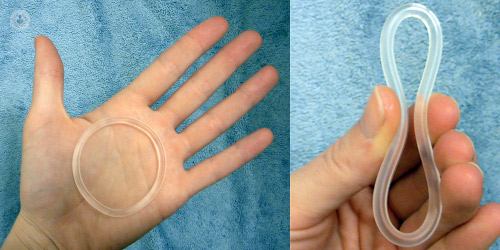Vaginal ring
Mr Haider Jan - Obstetrics & gynaecology
Created on: 11-13-2012
Updated on: 06-23-2023
Edited by: Karolyn Judge
What is the vaginal ring?
The vaginal ring, also known as the contraceptive ring, is a contraceptive method to avoid pregnancy. The ring sits inside the vagina and releases continuous doses of oestrogen and progestogen into the bloodstream to prevent pregnancy by preventing the ovaries from releasing an egg each month. The progestogen helps prevent sperm from entering the uterus by causing the mucus that exists in the cervix to thicken.

Is the vaginal ring better than the contraceptive pill?
When used correctly, the vaginal ring is more than 99% effective in preventing pregnancy. An advantage of the ring, compared to other methods such as the contraceptive pill, is that it will work if you have nausea or diarrhoea and does not require daily doses as the ring stays in place for a month at a time.
How does it work?
It is a flexible ring about five centimetres in diameter that is placed inside the vagina. The NHS says this monthly contraceptive must remain in the vagina for three weeks (21 days). You then have a 7-day ring-free break during which you will menstruate. During this week you are not protected against pregnancy. After the 7-day break you insert a new ring for the next 21 days. You can start to use the ring at any point in your menstrual cycle, and you will even be protected against pregnancy if you insert a ring on the first day of your period.
Who can use the vaginal ring?
For some women, the vaginal ring will not be a suitable contraceptive method. The following exclude your suitability for using the vaginal ring:
- You smoke or recently stopped smoking;
- You have obesity;
- You have had a blood clot before;
- You have high blood pressure;
- You have diabetes with complications;
- You have had breast cancer;
- You suffer from migraines.
What are the advantages and disadvantages of using the vaginal ring?
Advantages:
- No long-term effects on your fertility;
- It will still work when you have nausea or diarrhoea;
- It doesn't interrupt sex;
- You don't have to think about it every day;
- Periods may become lighter and less painful;
- It is easy to insert and remove.
Disadvantages:
- You may have spotting in the first few months of use;
- It does not protect against STIs;
- Temporary side-effects can include breast tenderness, headaches, and mood changes
- You may struggle to insert and remove it
- You must remember to remove it after 21 days, and then insert a new one after your 7-day break
